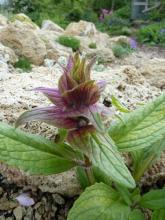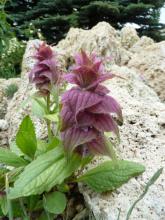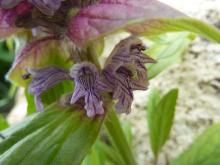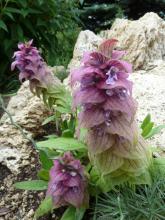After a period outdoors and exposure to the elements (including a few frosts and a couple of snowfalls!), some of this year's grown-under-lights-in-the-basement alpines are now making significant changes in form, from the rather loose, long-petioled, somewhat rambling things that were planted out, to the tighter forms that are more what one envisions.
Here are a few of the plants on which this change is most pronounced:
1) Campanula seraglio - the size of the leaves is greatly reduced... not that it was any giant before.
2) Ajuga lupulina - the old 8" stems will likely soon by abandoned, I imagine, in favour of the new, tight little rosette.
3) Ditto for Tanacetum tibeticum
4) Dracocephalum foetidum
5) Eritrichium pauciflorum ssp. sajanense
6) Campanula besenginica
7) Androsace spinulifera
Just thought it was kind of interesting to see these plants adapt to the conditions.
Comments
Re: Just sort of interesting...
Those are pretty drastic changes. A helpful FYI for the novice alpine seed grower, too.
I might add that such changes occur while still in the pot, too, from inside conditions to outside climates. These are Corydalis wilsonii grown from seed started this past winter. The last of the original "inside grown" leaves is turning, while the rest hang dried around the pots (cups). Leaves are quite thick, and there was a significant amount of shrinking as they dry.
The second pic was take while still growing inside the house. I'm not sure which growth pattern I like better...
I hope they survive my Minnesota winter.
Re: Just sort of interesting...
Rick, the second pic shows beautiful leaf tracery, I'd be good with that one :D Can you get Corydalis wilsonii by the keg? ;D ;D
Seriously though, I've heard from a number of NARGS members here in New England, and the consensus opinion is that C. wilsonii is not hardy and does not survive a New England winter. But is makes a beautiful alpine house / greenhouse plant.
Re: Just sort of interesting...
Do alpine enthusiasts commonly have alpine houses there, Mark? (Not used here, I don't think... I've seen one in Vancouver, BC, at the UBC gardens, where the wet winter climate necessitates it, presumably.) We only have a summer greenhouse - you'd go broke heating a 4-season one here! (Not to mention the power bills for supplemental lighting, given the weak winter light.)
More changes in form...
1) Hypericum aviculariifolium ssp. uniflorum - new tight growth in center.
Seeds from Pavelka, described as follows: "2500m, Dedegol Dag, Turkey; small plant 5cm, pubescent glaucous leaves, golden yellow flowers, very good."
2) Cheiranthus roseus... the dried-up petioles of old leaves are visible, while the rosette of newer growth is 1" across... note the aforementioned flower buds, whoo-hoo!! But... monocarpic (see below), acckkk! Oh well, hope they drop seeds. ;D
Seeds from Holubec, with the following description: "China: Bayan Har Shan, Qinghai, 5000m, fine gneiss scree; decorative dwarf monocarpic plant, 2-3 cm high, compact rosettes, linear leaves, many rose sessile flowers, 1 cm wide; 2007 seeds."
Re: Just sort of interesting...
Where did you get the C. wilsonii seed and what method of germination did you use?
Re: Just sort of interesting...
The Corydalis wilsonii seed came from a gardener in The Netherlands. She had contacted me, wanting some seed I had posted available. But for the past year, she hasn't been well, and hasn't been able to garden as usual. Her website: http://iris-garden.nl/
I was planning on giving the seed 2-4 weeks warm, than three months cold, to germinate in the spring, but seed came up in the first stage in 3 weeks at 70F. I also soaked seed for a few days at the end of March, planted April 1, and they came up about a month later. (Spring this year was about 3 weeks ahead of normal here.)
Re: Just sort of interesting...
Lori, that Hypericum looks like a small version of Sedum telephium. Seems to tolerate dryness. So does the Cheiranthus!
Something to try here I presume.
Re: Just sort of interesting...
Lori, that Hypericum looks like a small version of Sedum telephium. Seems to tolerate dryness. So does the Cheiranthus!
Something to try here I presume.
Lori, keep us posted on that Hypericum... I agree with Trond, looks rather sedum-like, so I'm anxious to see what it looks like when grown up.
Re: Just sort of interesting...
Yes, I agree - in the photos, the hypericum does looks hylotelephium-like... albeit like a very tiny one with 5mm long leaves! :)
Yesterday's hailstorm broke a piece of a stem off (among other things >:(), which has given me a convenient sample to look at closely!
The leaves are all opposite along the stem (not that that is necessarily convincing as I think the same could be said about some hylotelephiums/sedums), and are not succulent. They are instead thin, with a distinct midrib. The plant is finely hairy all over, too, so not sedum-like in that respect either.
Additionally, and more convincing of it actually being Hypericum, I think, is that when I look at the leaves with a 10x hand lens, I can see tiny dots on the leaves, similar to the little "windows" (I'm sure there's a proper term but what?) in the leaves of Hypericum perforatum. I think you can see a hint of this in the photos I attached. (Hey, the new camera takes decent macros!)
All the seedlings looked the same, too - no anomalies.
So, after some moments of doubt, I've convinced myself that it is probably what it is supposed to be! :)
Re: Just sort of interesting...
Lori, sorry to cause any doubt, I didn't mean to imply it was anything but a hypericum... it looks like a hypericum to me, just one that does an interesting superficial emulation of a sedum. The genus (hypericum) is quite diverse, with some very interesting things indeed. Someone on the SRGC recently posted a photo of H. bupleuroides, and unless you see this thing in flower, it would be hard to believe a plant with big rounded perfoliate leaves could be a hypericum, and a handsome one at that.
Re: Just sort of interesting...
Hey, no need to apologize! I tend to take things at face value, and look at them but not "see" them. Whenever I put a little effort into actually looking closely at something, trying to ID it, it is always great fun and a good learning experience! :D
Re: Just sort of interesting...
Sorry Lori, like Mark, I didn't mean to cause any doubt! I Rather think that this Hypericum can be tried here in a crack together with other succulents. The leaves are in fact very similar to one native at the west coast of Norway, Hypericum pulchrum, but yours have fatter more succulent leaves.
No picture but a link:
http://www.markblomster.com/Markblomster/Flora/F/Fagerperikum.html
Re: Just sort of interesting...
No worries!
Re: Just sort of interesting...
After a period outdoors and exposure to the elements (including a few frosts and a couple of snowfalls!), some of this year's grown-under-lights-in-the-basement alpines are now making significant changes in form, from the rather loose, long-petioled, somewhat rambling things that were planted out, to the tighter forms that are more what one envisions.
Here are a few of the plants on which this change is most pronounced:
1) Campanula seraglio - the size of the leaves is greatly reduced... not that it was any giant before.
2) Ajuga lupulina - the old 8" stems will likely soon by abandoned, I imagine, in favour of the new, tight little rosette.
3) Ditto for Tanacetum tibeticum
4) Dracocephalum foetidum
5) Eritrichium pauciflorum ssp. sajanense
6) Campanula besenginica
7) Androsace spinuliferaJust thought it was kind of interesting to see these plants adapt to the conditions.
Lori,
I looked closer at your picture of Tanacetum tibeticum. The leaves are very similar to one plant I had as Tanacetum sp. from Himalaya (Chadwell seeds). (It grew like yours before I planted it out too.)I sowed seed 3 years ago and planted out 1 ex in the spring 2009. This plant grew and managed to evolve into a dome-formed cushion 1m across with 1000 flowers! They lasted all summer and the plant died, apparently monocarpic. Sorry, no pictures!
The last days I have noticed small seedlings here and there. Do you recognize the leaves?
Re: Just sort of interesting...
Sorry, no, I don't know what it is, and haven't found anything similar by googling. Did it have yellow or white flowers? Sounds spectacular!
You might try posting your photo and question here:
http://www.srgc.org.uk/smf/index.php?board=18.0
Re: Just sort of interesting...
Sorry, no, I don't know what it is, and haven't found anything similar by googling. Did it have yellow or white flowers? Sounds spectacular!
You might try posting your photo and question here:
http://www.srgc.org.uk/smf/index.php?board=18.0
The flowers were like oxeye daisy but the leaves are similar to your Tanacetum tibeticum.
Re: Just sort of interesting...
Lori,
I need advice on what to do with Ajuga lupulina seed. I just received my Holubec order, and I may have additional questions as I work through them, but this one is special, as you already must know. Thanks in advance.
Re: Just sort of interesting...
Hi, Peter,
I started seeds of Ajuga lupulina on Feb. 26/10 at 20 deg C and got germination on March 8/10. The germination rate was low - my records aren't detailed enough to give details, but if I recall right, I only got a couple of sprouts, and I ended up with only one plant. The seeds were collected in 2008. So, it was encouraging to see quick germination (in 10 days) but maybe germination would have been better with conditioning/stratification.
I'll have to check if I have seeds left (I didn't collect any this year from it), as it would be a good idea to have a backup plant!
Unlike some of the other plants I showed in this thread, it remained fairly large as it developed, with the flower stalks reaching about 8" tall. I did post photos of the second-year plant in bloom elsewhere, but in case you missed it, here it is:
Re: Just sort of interesting...
Those are pretty drastic changes. A helpful FYI for the novice alpine seed grower, too.
I might add that such changes occur while still in the pot, too, from inside conditions to outside climates. These are Corydalis wilsonii grown from seed started this past winter. The last of the original "inside grown" leaves is turning, while the rest hang dried around the pots (cups). Leaves are quite thick, and there was a significant amount of shrinking as they dry.
The second pic was take while still growing inside the house. I'm not sure which growth pattern I like better...
I hope they survive my Minnesota winter.
Cool Corydalis, Rick... at first glance, quite similar to the local C aurea, but the leaves are bluer close up, really nice form...
Re: Just sort of interesting...
Leucanthemum vulgare is a very variable species, at least in Norway, and it grows almost everywhere.
Several forms are common along roads etc. These are often taller and coarser than those found in meadows etc.
At our cabin in the mountains grows a smaller, more refined form that spread by creeping rhizomes. We also have two other forms that are taller and not spreading in the same way.
To the left: The smaller form, to the right: The bigger form. It is easier to see the differences when you see both at the same time!
Re: Just sort of interesting...
Is it native to Norway or introduced? I often find it difficult to find out the natural ranges of European plants. (I did see that it is native to the UK.) That one is pretty but, unfortunately, is a very invasive and widespread plant in North America.
Re: Just sort of interesting...
I agree Lori, the oxeye Leucanthemum vulgare (syn. Chrysanthemum vulgare) is an in an introduced weed throughout North America; I'm always ripping this plant out. It is listed on a number of State noxious weed lists, and generally considered an undesirable invasive.
http://plants.usda.gov/java/profile?symbol=LEVU&mapType=nativity&photoID...
http://en.wikipedia.org/wiki/Leucanthemum_vulgare
Re: Just sort of interesting...
It is native here but some forms are probably introduced. And although it is invasive in disturbed areas it is in fact declining in some places, notably pastures. Some forms are rather shortlived but others (like the left shown above) are almost perpetual ;)
Re: Just sort of interesting...
I have only seen one form of this invasive here in Minnesota. But I suppose that would be the norm: being variable in its place of origin, and not so much where it has been introduced. It is fairly widespread throughout the state, but really only common in the northern half, at least from what I have seen.
Re: Just sort of interesting...
Trond: I would be interested in getting hold of your different forms of Leucanthemum vulgare next time you're up here :)
Re: Just sort of interesting...
It's a bit difficult, Stephen. Next time is - vinterferie! But when the snow thaws ;)
Re: Just sort of interesting...
I can probably wait that long :)





Very interesting Lori! I had wondered about some of the early pics of your seedlings, as many looked like largish open-growing plants; but there were obviously out of form from being grown under lights. At least they have made successful transition from the inside environment to being outdoors. Very interesting to see these developments and a good lesson to growers of seedling plants.